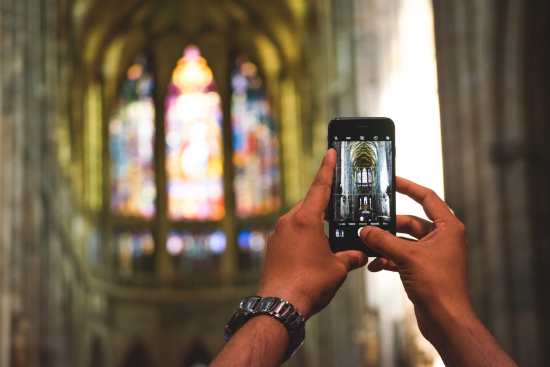As the country deals with the COVID-19 virus outbreak, churches in Central Florida and around the country are refocusing their ministry efforts to virtual gatherings and digital connections for information. In Florida, Gov. Ron DeSantis recently issued a statewide stay-at-home order from Apr. 3 at 12:01 a.m. through Apr. 30. Despite these disruptions to local ministry, the church can be proactive in its efforts.
Churches with limited resources can still broadcast a quality service, according to The Rev. Lorenzo Lebrija of St. Paul’s Cathedral in the Episcopal Diocese of San Diego. In a recent YouTube video, “How to Livestream Your Church Service in 4 Easy Steps,” he explained that anyone who has a smartphone has streaming capability.
“You only need two things: a cell phone and a tripod,” he said.
Lebrija also advised churches without a Facebook page to begin one and to find a volunteer who can start and stop the recording for use with Facebook Live.
As a church shifts its attention online, the biggest challenge is to get the word out. Staff members should prioritize updating church records with even the most recent visitors so everyone knows where to turn when the church begins broadcasting.
“We sent a mass email using MailChimp, a free service,” said The Rev. Rob Goodridge of St. Gabriel’s Episcopal Church in Titusville, adding that eztexting.com helped the church spread the word through text messages and prerecorded phone calls.
Goodridge also used St. Gabriel’s traditional methods of communication, including pastoral letters, social media announcements and a full-service virtual bulletin. Because of this, the church was able to notify most of its 400 congregants, with only four people showing up on March 15, three of whom had never come before. Beyond announcements, there’s a deeper reason for using every possible means for communicating to congregants, he believes.
“We converted our parish directory, made a separate page [on the church website] for it, password protected in PDF format that can be downloaded and printed,” Goodridge said. “We encourage our folks to use it to call, email, snail mail and text each other. Isolation will be a huge obstacle for us over the next few months.”
Churches should also be intentional about promoting online giving. Simple Tithe, Txt2Give, Pushpay and nonprofit fundraising directly through Facebook are some options to help keep churches’ finances as steady as possible. Facebook requires an application approval for giving without a surcharge, while the other services can add usage fees from 2-3%.
Service planning for a livestream service also includes some additional challenges. Many churches don’t realize that their current Christian Copyright Licensing International (CCLI) license to perform copyrighted music doesn’t cover streaming. Rather than bypass the music, however, a church can purchase an add-on license for as little as $63 a year. Since prerecorded accompaniment music falls outside that license, please check with CCLI for specifics.
St. Gabriel’s March 15 service included morning prayer with homily and the singing of canticles, including an organ prelude and postlude. According to Goodridge, “there were six people involved: the officiant, a singer, two readers, a verger and a video person.”
As the world faces a unique, unprecedented challenge, churches are responding with vigor and optimism.
“This is an opportunity for us to take Jesus further and further out into the world,” Lebrija commented in his video.
Goodridge said the coronavirus-necessitated move toward increased online ministry has shifted St. Gabriel’s website. Whereas in the past, the church used its online presence primarily to attract new members, the site now serves as a safe gathering place for congregants.
“The website is being rebuilt,” Goodridge said. “Our focus has changed from an on-ramp to newcomers to creating a virtual church for everyone.”

